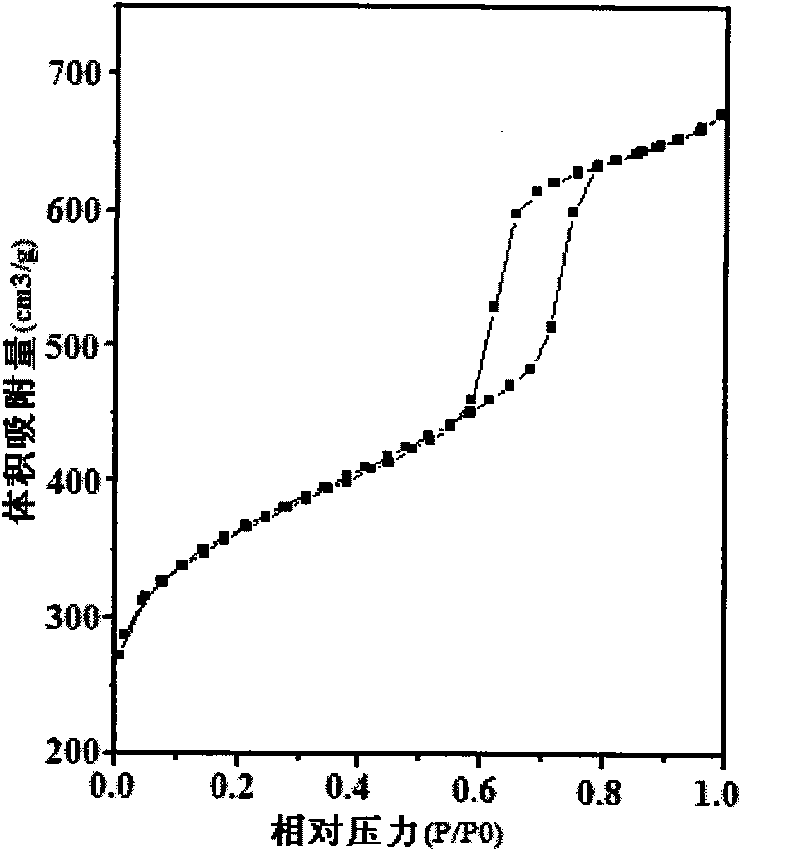Preparation method for organic functional ordered mesoporous titanium oxide silicon molecular sieve
A technology of mesoporous titanium oxide and silicon molecular sieves, applied in the direction of crystalline aluminosilicate zeolites, etc., can solve the problems of uneconomical synthesis and difficulty of hybrid mesoporous silicon oxide molecular sieves, and achieve high mesoscopic order and low production cost Inexpensive, the effect of uniform distribution of organic functional groups
- Summary
- Abstract
- Description
- Claims
- Application Information
AI Technical Summary
Problems solved by technology
Method used
Image
Examples
Embodiment 1
[0030] a) Add 2.0g of surfactant-P123 into 30g of 1M hydrochloric acid aqueous solution, stir at 40°C until the surfactant is completely dissolved and the solution is clear;
[0031] b) Add 3.61 mL of inorganic silicon source-tetraethyl orthosilicate (TEOS) dropwise at 40°C to the above solution, stir at 40°C for 30 minutes, then add 0.29mL of organic silicon source-1,2-bis( Triethoxysilane) ethane (BTESE), continue stirring for 1 to 2 hours;
[0032] c) Add 0.78mL of inorganic titanium source-TiCl drop by drop 3 , continue stirring at 40°C for 22 hours;
[0033] d) carrying out a hydrothermal reaction at 100° C. for 24 hours;
[0034] e) After cooling, a white powder is obtained after suction filtration, washing, and natural drying at room temperature;
[0035] f) Reflux extraction with ethanol solvent for 24 hours, cooling, suction filtration, washing, and drying to obtain: an organic functional ordered mesoporous titanium oxide silicon molecular sieve with a silicon-tita...
Embodiment 2
[0042] a) Add 2.0g of surfactant-P123 into 45g of 0.5M hydrochloric acid aqueous solution, and stir at 40°C until the surfactant is completely dissolved and the solution is clear;
[0043] b) First add 3.39mL of inorganic silicon source-orthoethyl silicate (TEOS) dropwise to the above solution at 40°C
[0044] solution, stirred at 40°C for 30 minutes, then added 0.28 mL of organosilicon source-1,2-bis(triethoxysilyl)ethane (BTESE), and continued to stir for 1 to 2 hours;
[0045] c) Add 1.0 mL of inorganic titanium source-TiCl drop by drop 3 , continue stirring at 40°C for 22 hours;
[0046] d) carrying out a hydrothermal reaction at 100° C. for 24 hours;
[0047] e) After cooling, a white powder is obtained after suction filtration, washing, and natural drying at room temperature;
[0048] f) Reflux extraction with ethanol solvent for 24 hours, cooling, suction filtration, washing, and drying to obtain: an organic functional ordered mesoporous titanium oxide silicon molecu...
Embodiment 3
[0053] a) Add 2.0g of surfactant-P123 into 45g of 0.5M hydrochloric acid aqueous solution, and stir at 40°C until the surfactant is completely dissolved and the solution is clear;
[0054] b) Add 3.35 mL of inorganic silicon source-tetraethyl orthosilicate (TEOS) dropwise at 40°C to the above solution, stir at 40°C for 30 minutes, then add 0.27mL of organic silicon source-1,2-bis( Triethoxysilane) ethane (BTESE), continue stirring for 1 to 2 hours;
[0055] c) Add 1.28mL of inorganic titanium source-TiCl drop by drop 3 , continue stirring at 40°C for 22 hours;
[0056] d) carrying out a hydrothermal reaction at 100° C. for 24 hours;
[0057] e) After cooling, a white powder is obtained after suction filtration, washing, and natural drying at room temperature;
[0058] f) Reflux extraction with ethanol solvent for 24 hours, cooling, suction filtration, washing, and drying to obtain: an organic functionalized ordered mesoporous titanium oxide silicon molecular sieve with a si...
PUM
| Property | Measurement | Unit |
|---|---|---|
| pore size | aaaaa | aaaaa |
| pore size | aaaaa | aaaaa |
| specific surface area | aaaaa | aaaaa |
Abstract
Description
Claims
Application Information
 Login to View More
Login to View More - R&D
- Intellectual Property
- Life Sciences
- Materials
- Tech Scout
- Unparalleled Data Quality
- Higher Quality Content
- 60% Fewer Hallucinations
Browse by: Latest US Patents, China's latest patents, Technical Efficacy Thesaurus, Application Domain, Technology Topic, Popular Technical Reports.
© 2025 PatSnap. All rights reserved.Legal|Privacy policy|Modern Slavery Act Transparency Statement|Sitemap|About US| Contact US: help@patsnap.com



